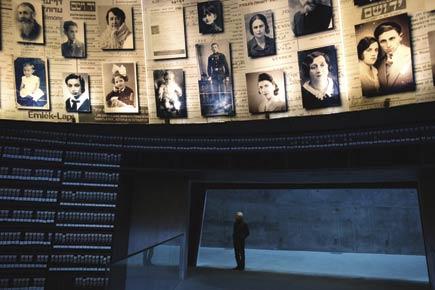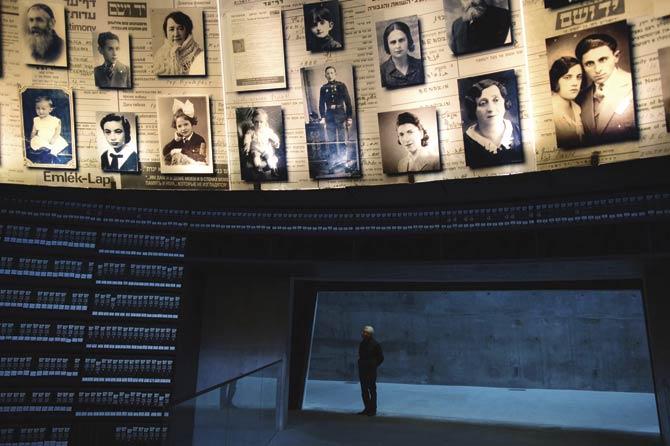I have crossed the Bridge to a Vanished World to enter the cavernous halls of Yad Vashem several times

 Jerusalem: I have crossed the Bridge to a Vanished World to enter the cavernous halls of Yad Vashem several times. And each time I have emerged from the tunnel, at the end of which there is light, depressed and melancholic. My visit to the Holocaust Memorial was no different this week. A certain sadness engulfed me as I stepped out of the memorial, from the shadows of history into the sunlight of the present. The silence hung heavy.
Jerusalem: I have crossed the Bridge to a Vanished World to enter the cavernous halls of Yad Vashem several times. And each time I have emerged from the tunnel, at the end of which there is light, depressed and melancholic. My visit to the Holocaust Memorial was no different this week. A certain sadness engulfed me as I stepped out of the memorial, from the shadows of history into the sunlight of the present. The silence hung heavy.

The hall of names in the Yad Vashem Holocaust Memorial. The memorial stands perched precariously in a cleft between two hills, a grey concrete structure that holds within its walls the collective memory of six million Jews, a third of the community, killed in Europe by the Nazis. Pic/AFP
ADVERTISEMENT
The Holocaust Memorial stands perched precariously in a cleft between two hills, a grey concrete structure that holds within its walls the collective memory of six million Jews, a third of the community, killed in Europe by the Nazis. They were exterminated in the most brutal manner after being denuded of dignity and disrobed of honour.
Three million Jews were killed in Poland alone (Germany had half-a-million Jews), most of the rest in eastern Europe as Adolf Hitler’s macabrely efficient death machines, also known as concentration camps, went about the hideous task of implementing his ‘Final Solution’. Tales of gut-wrenching horror are well-known, courtesy innumerable films and books.
Many of the few who survived could never cope with the burden of history. Primo Levi, author of If This Is a Man recording his year at Auschwitz, committed suicide after battling the demons of the past for years. Frederick Forsyth’s The Odessa File, the book and the eponymous movie, is a popular version, fictional though every bit true, of what it meant to be a Jew as Hitler and the the Nazis ran amok.
Yad Vashem was originally set up to commemorate the memory of the six million Jews who perished. It was not about individuals or families or groups, but the community as a whole. The dilemma of whose story to recall, which death to highlight, was resolved through a collective tribute. After all, no single tale of grief and horror told the story of the Holocaust; there were and remain more tales than can be recounted.
In recent years there has been a shift from that practice. A distance separates the new generation of Jews from the darkness that engulfed the Jews of Europe in the 1930s and the 1940s. The struggle for survival has been no less intense since then, but Israel is a far cry from the ghettoes of Poland.
The passage of time and the passing of generations has necessitated the telling of the story of the Holocaust from the experiences of individuals. Yad Vashem, which freezes some of the darkest, bleakest moments of history, has moved with the times. The saplings planted along the Avenue of the Righteous Among the Nations, each in honour of a non-Jew who reached out to save Jewish lives while risking his or her own life, have grown into trees.
Among them is one that honours Oskar Schindler who sheltered Jews, and in death found his eternal resting place in a cemetery along the walls of Jerusalem. The Jews, you will often be told by a Jew, never
forget their friends. It is not empty rhetoric. Nor is it an empty threat when a Jew vows not to forgive his enemy.
Judaism is one of the ancient religions that have survived the savagery of time. It is the oldest among the Abrahamic faiths. Its adherents may be numerically few (there are an estimated 14 million Jews in the world today, less than half of them in Israel) but they are fiercely proud of their Jewishness which encapsulates both cultural identity and civilisational history. In Israel, it also defines their will of survival.
Masada prompted Jews to say, Never again. But then the Holocaust happened. The rebirth of Israel and the recreation of a Jewish homeland has made the ancient resolve stronger: ‘Never again’ is both a conviction and a belief that the Jews cannot, must not and shall not accept defeat. Yet there is a fragility, even more so as the Middle East rapidly changes its profile, about the Jewish state that cannot be wished away.
It is this sense of fragility that is reflected in the architecture of Yad Vashem, perched on the edge of a cleft between two hills. In many ways Israel too lives on the edge, now more than ever, as tectonic shifts occur in the landscape of the Middle East, changing the region forever, driving it towards an unpredictable future. Looming above all is Iran, recalling the dark shadows of the past. The distance between the Holocaust and the present suddenly does not seem so long.
The writer is a senior journalist based in the National Capital Region. His Twitter handle is @KanchanGupta
 Subscribe today by clicking the link and stay updated with the latest news!" Click here!
Subscribe today by clicking the link and stay updated with the latest news!" Click here!







